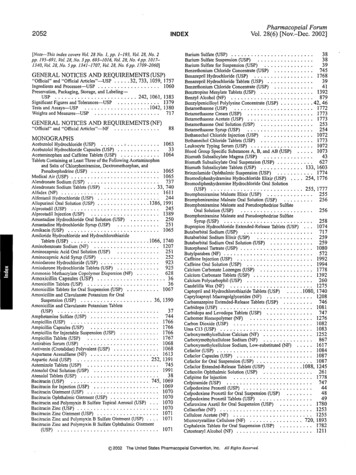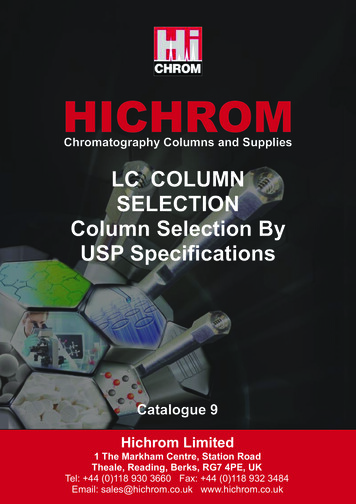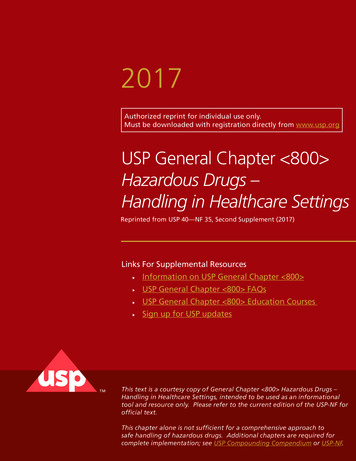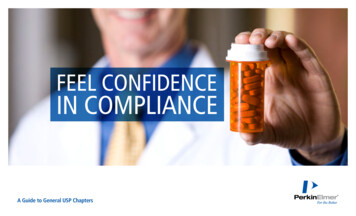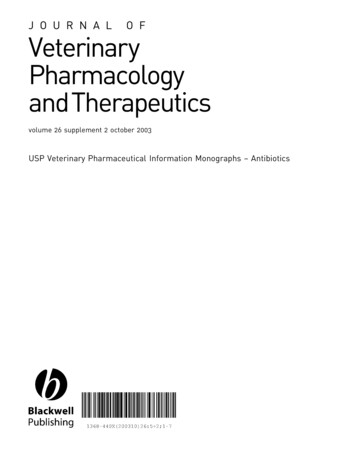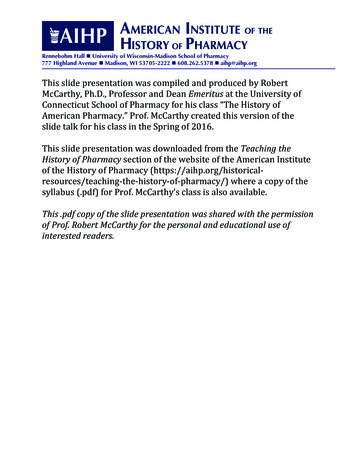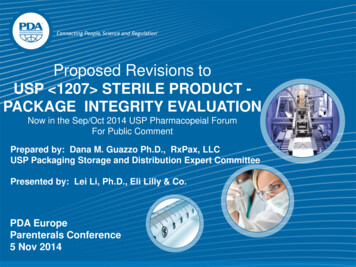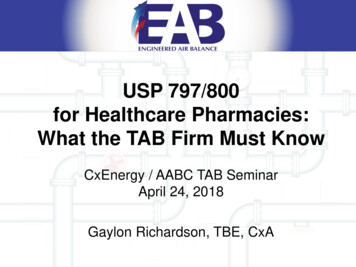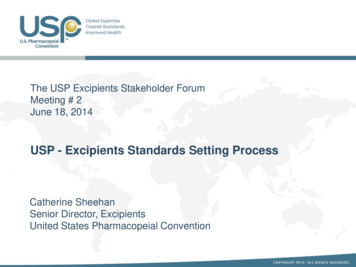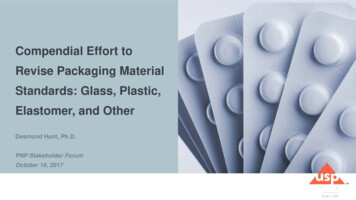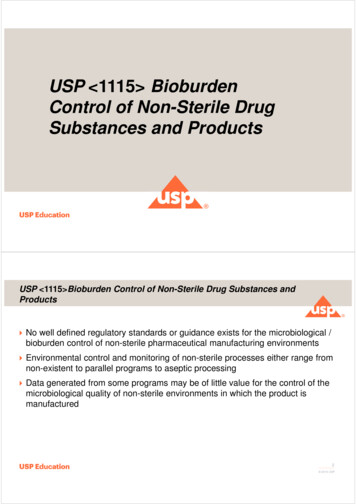
Transcription
USP 1115 BioburdenControl of Non-Sterile DrugSubstances and ProductsUSP 1115 Bioburden Control of Non-Sterile Drug Substances andProducts No well defined regulatory standards or guidance exists for the microbiological /bioburden control of non-sterile pharmaceutical manufacturing environments Environmental control and monitoring of non-sterile processes either range fromnon-existent to parallel programs to aseptic processing Data generated from some programs may be of little value for the control of themicrobiological quality of non-sterile environments in which the product ismanufactured2 2019 USP
ApproachSo, how do we effectively apply microbial control in the manufacture ofnon-sterile products? Microbial contamination in non-sterile products is controlled to a level consistentwith patient safety, but excessive controls that would add complexity/costwithout a commensurate safety benefit are not advantageous to either the enduser or the manufacturer. Therefore, a scientifically pragmatic approach to management of the microbialbioburden in non-sterile products requires consideration of patient risk and thecontamination control objectives required to achieve a practical level of riskmanagement.3 2019 USPApproach Use HACCP to understand the process–Hazard Analysis & Critical Control Points (HACCP) is a safety management system that relieson process controls to minimize risks Define where microbial contamination could occur Effectively determine the best control and monitoring methods4 2019 USP
Hierarchy of Product Risk A hierarchy of non-sterile drug dosage forms with potential risk (high to low) toend users from a microbial contamination perspective is:–Metered-dose and dry powder inhalants–Nasal sprays–Otics–Vaginal suppositories–Topicals–Oral liquids (aqueous)–Oral liquids (non-aqueous)–Rectal suppositories–Liquid-filled capsules–Compressed tablets and powder-filled capsules5 2019 USPNon-Sterile Product Microbial Influences6 2019 USP
USP 1115 Bioburden Control of Non-SterileDrug Substances and Products While there are many factors that can result in the introduction ofmicroorganisms, recent data on product failures and recalls indicate that thefollowing factors are the most likely to result in product recalls due to higher thanacceptable levels of microbiological content. These manufacturing risk factorsare, in descending order: (1) ingredient water, (2) pharmaceutical ingredients,(3) process equipment, and (4) manufacturing personnel and (5) manufacturingenvironment.7 2019 USPRegulatory Guidance Appropriate written procedures, designed to prevent objectionablemicroorganisms in drug products not required to be sterile, shall be establishedand followed (21 CFR 211.113 Control of microbiological contamination).8 2019 USP
Product DevelopmentPoints to be considered by pharmaceutical microbiologists and productdevelopment teams when assessing the potential risk associated are: Synthesis, isolation, and final purification of the drug substance Microbial attributes of the drug substance Microbial attributes of the pharmaceutical excipients Formulation and microbial, chemical and physical attributes of the drug product9 2019 USPProduct DevelopmentPoints to consider: Water activity of the drug product Manufacturing process for the drug product Delivery system for the drug product Packaging of the drug product Storage conditions for the finished dosage form Route of administration of the drug product Expected treatment procedure and dosage regime Age and medical status of the intended recipients of the drug product10 2019 USP
Water Process water is the single most important risk element contributing to thecontamination of nonsterile products. The quality or type of water used fornonsterile product formulation and final rinse of clean equipment should bechosen based on product risk. Purified waters used in pharmaceuticalmanufacturing are deionized and thus do not contain chlorine to controlmicrobial growth.11 2019 USPWater Substantial populations of Gram negative rod-shaped bacteria and many moldsare able to grow in such purified dechlorinated water. Therefore, purified watershould not be allowed to stand in pools or puddles for extended periods of time. Standing purified water should be drained or physically removed quickly andefficiently from both production vessels and equipment, as well as work surfacesand floors.12 2019 USP
Water Process waters used for manufacturing of, excipients, and, in some cases,active ingredients for nonsterile products present a substantial risk for microbialcolonization and proliferation, particularly for ingredients of natural origin thathave received minimal processing to reduce bioburden or to control microbialproliferation.13 2019 USPPharmaceutical Ingredients Ingredients and excipients utilized in process formulation can be a significantsource of microbial contaminants and are in fact the second leading cause ofproduct recalls for microbial contamination. Vendor audits, specifications, testing, package selection, shipping, storageconditions and expiry dates are all critical in the reduction of microbial riskassociated with these materials.14 2019 USP
Pharmaceutical Ingredients When manufacturers cannot conduct extensive vendor audits, they shouldselect vendors with the demonstrated capacity to produce drug substances orexcipients of suitable quality. Of particular concern are unprocessed materials of natural origin and those thathave a high level of water activity.15 2019 USPPharmaceutical Ingredients Supplier audits should be conducted to establish that the supplier has a welldesigned and validated microbiological control program for its manufacturingand packaging facilities. Depending on the microbial characteristics of aningredient, manufacturers should consider periodic monitoring of the supplier’sfacility to assess microbiological contamination.16 2019 USP
Pharmaceutical Ingredients Materials that have low water activity, possess high or low pH, are not of naturalorigin, are inherently antimicrobial, or contain an antimicrobial preservative havea low risk for microbial colonization or proliferation. Risk assessments should consider ingredient characteristics regarding microbialsurvival, support of microbial growth, or frank antagonism to microbial survival.17 2019 USPPharmaceutical Ingredients The introduction of moisture into stored materials notably increases the risk ofmicrobial contamination. Condensation in storage tank headspace or impermeable storage containerscan result in contamination of materials with water-borne organisms even whenthe product under storage is expected to preclude microbial colonization orproliferation.18 2019 USP
Pharmaceutical Ingredients Manufacturers also should consider the suitability of methods for detectingrelevant noncompendial organisms. Primary packaging and intermediate containers (e.g., drum liners, plastic bags,and so on) can be a source of microbial contamination, and manufacturersshould consider their initial quality, storage conditions, preparation, and handlingprocedures.19 2019 USPEquipment Design and Use Formulating and manufacturing equipment can be a source of contamination,and risks are higher when water and ingredients that are susceptible tomicrobial survival or growth are used.20 2019 USP
Equipment Design and Use Cleaning, drying, and, where appropriate, sanitization of manufacturingequipment can be beneficial, but disinfectant residues should be limited in theoperating environment and should be removed from product-contact surfaces. The isolation of water-borne organisms, particularly Gram negative rods, is alikely indicator of failure to remove standing water on equipment andenvironmental surfaces21 2019 USPEquipment Design and Use Equipment specifications for the selection of equipment to be used in themanufacture of non-sterile products should include sanitary design; clean abilityof equipment to allow removal of contaminants. Equipment should use sanitary fittings and be designed for easy use of cleaningand sanitizing agents and complete rinse water drainage.22 2019 USP
Equipment Design and Use Residual water in tanks, piping, or on equipment surfaces introduces the risk ofcolonization by water-borne organisms. Manufacturing equipment that cannot be cleaned in place should be readilyaccessible for manual cleaning, and parts that must be cleaned out of placeshould be not only easily accessible but also readily or easily removable.23 2019 USPEquipment Design and Use A further consideration is the compatibility of equipment with the typical range ofdisinfectants, including sporicides, used in cleaning procedures to sanitizeequipment.24 2019 USP
Process Equipment Cleaning and sanitization processes should include the evaluation of microbialcontent both after sanitization and before use. Properly designed storage protection should mitigate the possibility of microbialgrowth before use, so after proper storage conditions are validated ongoingmonitoring of equipment and utensils should not be required.25 2019 USPProcess Equipment Surface microbial sampling either immediately after cleaning or immediatelybefore use must be done with caution; media residues and residual moisturemust be carefully eliminated if sampling is performed.26 2019 USP
Process Equipment It is important to evaluate whether products that are manufactured using a pieceof processing equipment may, under some processing circumstances, promotethe growth of microorganisms. This evaluation is necessary to properly establish processing hold times and todefine equipment use conditions post-cleaning. Intermediates that require holdtimes include granulation solution, wet granulations, film coating solution andaqueous material prior to the addition of antimicrobial preservatives.27 2019 USPPersonnel In addition to emphasis on personal hygiene, operators should be trained anddressed appropriately for the function they are performing Attention should be given to when product is exposed to manufacturingpersonnel in open systems28 2019 USP
Design elements to control microbial contamination Common design elements to control microbial contamination may include thefollowing:–Walls, ceilings, and floors are constructed of nonporous materials that are readily cleanableand are resistant to cleaning agents and disinfectants.29 2019 USPDesign elements to control microbial contamination Floor drains are permitted in nonsterile product manufacturing areas providedthat they can be closed during processing or fitted with a suitable air break ifthey are open during area and equipment cleaning. Access should be limited to essential personnel. Material, equipment, and personnel flows should avoid contamination.30 2019 USP
Design elements to control microbial contamination Ventilation and air filtration should be adequate to maintain the specifiedcleanliness, space pressurization (if required), temperature, and relativehumidity. Good housekeeping and good general hygiene should be applied at all times.31 2019 USPDesign elements to control microbial contamination Cleaning and use status of all tools and implements used in production and allprocess equipment should be known at all times. Product-contact or water-supply tubing, valves, and fittings should be cleanedand sanitized according to a defined schedule, should be stored dry, and shouldbe labeled with respect to status32 2019 USP
Design elements to control microbial contamination Manufacturers should implement a formal housekeeping and sanitizationprogram for operating areas, corridors, equipment storage, material staging, andother common areas. Classified environments are not required for nonsterile product manufacturing,e.g., those specified in ISO 14644-133 2019 USPMicrobial Monitoring A monitoring program, commensurate with the risk, may be of value confirmingthe effectiveness of microbiological controls and in early detection of potentialproblems within the manufacturing areas. The microbial methods and practices utilized for aseptic facilities may beutilized; however the contamination recovery rates defined in 1116 Microbiological Control and Monitoring of Aseptic Processing Environments areNOT intended for non-sterile environments.34 2019 USP
Microbial Monitoring Unlike aseptic processing for which facility requirements are generally uniform inspecification and performance, nonsterile product manufacturing environmentstypically involve diverse products and microbial contamination controlrequirements. In general, liquid, cream, or ointment products require a greater level ofcontamination risk mitigation than do solid dosage forms35 2019 USPMicrobial Monitoring The frequency of monitoring should reflect the potential risk associated with thedosage form Products that are resistant to microbial colonization or have microbiocidal ormicrobiostatic characteristics require little or no microbiological monitoring. In general, environments for tablet and powder- and liquid-filled capsulemanufacturing should require no monitoring or infrequent monitoring.36 2019 USP
Microbial Monitoring Monitoring programs should be risk based, and the intensity and number ofsampling sites should reflect the risk level. Manufacturing areas for higher-riskdosage forms such as inhalant products require more frequent monitoring andtypically are manufactured in rooms classified to a particulate air quality level,e.g., ISO 8.37 2019 USPMicrobial Monitoring For most nonsterile product manufacturing environments, because of theirlimited environmental controls and comparatively low product risk, theestablishment of alert and action levels may not be required. Environmentalmonitoring is considered an informational survey of the general hygienicconditions of the environment and should not be used in product-releasedecisions.38 2019 USP
Overall Program The management of a successful microbiological control program includes thefollowing: identification of suitable suppliers of pharmaceutical ingredients andexcipients that have good microbiological quality; conducting a microbial riskassessment of the manufacturing process and packaging system; and theestablishment of an appropriate monitoring and control system.39 2019 USPOverall Program Although environmental contamination is by no means the most significantcause of nonsterile product recalls or contamination events, environmentalmonitoring may be a useful component in the overall microbiological controlprogram.40 2019 USP
Overall Program The microbiological contamination control program should be developed foridentifying and controlling product risk-based on a formal assessment of riskmodalities. The risk analysis should result in the identification of critical controlpoints and should facilitate proper equipment selection, process layout anddesign, and facility requirements.41 2019 USPOverall Program Critical factors for the prevention of microbiological contamination duringnonsterile product manufacturing are control of the microbiological quality ofingredients and water, along with the development of proper cleaning andsanitization procedures. Microbiological monitoring does not mitigate risk, but it can serve as a sentinel.42 2019 USP
Overall Program No monitoring program can provide the assurance of contamination control likea proper proactive analysis of potential sources of contamination followed by theadoption of sound preventive measures. Consistent control of contamination canbe achieved mainly by process evaluation via risk assessment and studies toensure that measures are in place to prevent conditions conducive tocontamination.43 2019 USP
non-existent to parallel programs to aseptic processing Data generated from some programs may be of little value for the control of the microbiological quality of non-sterile environments in which the product is manufactured USP 1115 Bioburden Control of Non-Sterile Drug Substances and Products
